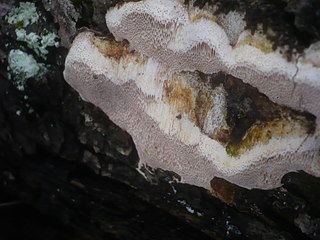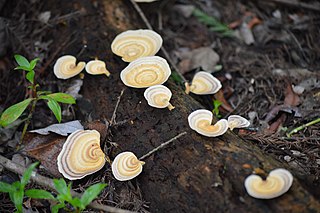
Junghuhnia is a genus of crust fungi in the family Steccherinaceae. It was circumscribed by Czech mycologist August Carl Joseph Corda in 1842. The generic name honours German-Dutch botanist Franz Wilhelm Junghuhn.

The Polyporaceae are a family of poroid fungi belonging to the Basidiomycota. The flesh of their fruit bodies varies from soft to very tough. Most members of this family have their hymenium in vertical pores on the underside of the caps, but some of them have gills or gill-like structures. Many species are brackets, but others have a definite stipe – for example, Polyporus badius.

Perenniporia is a cosmopolitan genus of bracket-forming or crust-like polypores in the family Polyporaceae. They are dimitic or trimitic with smooth, thick-walled basidiospores and cause a white rot in affected wood.

Rigidoporus is a genus of fungi in the family Meripilaceae. Many of the species in this genus are plant pathogens. The widespread genus, which contains about forty species, was originally circumscribed by American mycologist William Alphonso Murrill in 1905. The generic name combines the Latin word rigidus ("rigid") with the Ancient Greek word πόρος ("pore").

Postia is a genus of brown rot fungi in the family Fomitopsidaceae.

Cerrena is a genus of poroid fungi in the family Polyporaceae. The genus was circumscribed by Samuel Frederick Gray in 1821. Gray's type species, Cerrena cinerea, is now known as C. unicolor.

Gloeoporus is a genus of crust fungi in the family Irpicaceae. The genus has a widespread distribution.

Ceriporia is a widely distributed genus of crust fungi.

Antrodiella is a genus of fungi in the family Steccherinaceae of the order Polyporales.

Irpex is a genus of corticioid fungi in the order Polyporales. Species produce fruit bodies that grow as a crust on the surface of dead hardwoods. The crust features an irpicioid spore-bearing surface, meaning it has irregular and flattened teeth. Irpex is distinguished from the similar genera Junghuhnia and Steccherinum by the simple septa found in the generative hyphae.

Aurantiporus is a genus of poroid fungi in the family Meruliaceae. Circumscribed by American mycologist William Alphonso Murrill in 1905, the genus contains five species found mostly in northern temperate regions. Molecular analysis of several Aurantiporus species suggests that the genus is not monophyletic, but some other related polypore species need to be sequenced and studied before appropriate taxonomic changes can be made. In 2018, Viktor Papp and Bálint Dima proposed a new genus Odoria to contain Aurantiporus alborubescens based on multigene phylogenetic analyses. The generic name is derived from the Latin aurantius ("orange") and the Ancient Greek πόρος (pore).

Coriolopsis is a genus of fungi in the family Polyporaceae. It was circumscribed by American mycologist William Alphonso Murrill in 1905. The genus is cosmopolitan, with most species in tropical areas. The generic name combines the name Coriolus with the Ancient Greek word ὄψις ("appearance").

Datronia is a genus of poroid crust fungi in the family Polyporaceae. The genus was circumscribed by Marinus Anton Donk in 1966, with Datronia mollis as the type species. Datronia fungi cause a white rot in hardwoods. Datronia contains six species found in northern temperate areas. The most recent addition, Datronia ustulatiligna, was described in 2015 from Himachal Pradesh in India.
Grammothelopsis is a fungal genus in the family Polyporaceae. It was circumscribed in 1982 by Swiss mycologist Walter Jülich, with Grammothelopsis macrospora as the type species.

Microporellus is a genus of poroid fungi in the family Polyporaceae.

Nigroporus is a genus of poroid fungi in the family Steccherinaceae. The genus was circumscribed by American mycologist William Alphonso Murrill in 1905. Nigroporus has a pantropical distribution. The genus name combines the Latin word niger ("black") with the Ancient Greek word πόρος ("pore").

Skeletocutis is a genus of about 40 species of poroid fungi in the family Polyporaceae. The genus has a cosmopolitan distribution, although most species are found in the Northern Hemisphere. Skeletocutis causes a white rot in a diverse array of woody substrates. Their fruit bodies grow as a crust on the surface of the decaying wood. Sometimes the edges of the crust are turned outward to form rudimentary bracket-like caps.

Tyromyces is a genus of poroid fungi in the family Polyporaceae. It was circumscribed by mycologist Petter Karsten in 1881. The type species is the widely distributed Tyromyces chioneus, commonly known as the white cheese polypore. The phylogenetic position of Tyromyces within the Polyporales is uncertain, but it appears that it does not belong to the "core polyporoid clade". Tyromyces is polyphyletic as it is currently circumscribed, and has been described as "a dumping place for monomitic white-rot species with thin-walled spores."

Nigroporus vinosus is a species of poroid fungus in the family Steccherinaceae, and the type species of the genus Nigroporus. Its fruit bodies have brownish caps with tinges of purple or red. The cap underside has a pore surface the same colour as the cap, and minute pores. Nigroporus vinosus has a pantropical distribution. It has been recorded from Africa, North America, Central America, South America, Asia, and Oceania. It is a wood-decay fungus that causes a white rot.
Skeletocutis stramentica is a species of poroid fungus in the family Polyporaceae that is found in New Zealand.

















